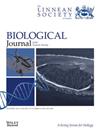三刺鱼信号变化后感觉系统的进化
IF 1.5
3区 生物学
Q3 EVOLUTIONARY BIOLOGY
引用次数: 0
摘要
感官驱动可导致信号的进化,这些信号在感知环境中得到优化。然而,当环境条件发生变化时,信号、环境和接收者之间的相互作用也可能发生变化,从而导致新的最佳信号进化或性信号的更多分类变化(增益或减益)。我们评估了环境和雄性信号发生变化后视觉系统是如何进化的,以及视觉系统的分化是否导致了西北太平洋淡水三刺鱼红色和黑色形态祖先与衍生类型之间的生殖隔离。我们发现,在红移的光背景下,视蛋白序列可增强黑色鱼类的感知对比度,而视蛋白表达则不然。此外,我们没有发现颜色形态之间存在同型偏好或同类交配的证据;两种形态的雄鱼在无选择交配情境中同样成功,这可能是因为黑色雄鱼求偶更积极。总之,我们的研究结果表明,黑刺鱼栖息地的转变导致了感官驱动力动态的转变,视觉系统和行为的某些方面随着其他因素(觅食或捕食)而进化,或滞后于红移环境中视蛋白序列的进化。本文章由计算机程序翻译,如有差异,请以英文原文为准。
The evolution of sensory systems after signal change in threespine stickleback
Sensory drive can lead to the evolution of signals that are optimized to the environment in which they are perceived. However, when environmental conditions change, the interactions between signal, environment, and receiver may also shift, leading to the evolution of a new signal optimum or more categorical shifts in sexual signals (gains or losses). We evaluated how visual systems have evolved following a change in environment and male signal, and whether visual system divergence contributes to reproductive isolation between ancestral and derived types in red and black morphs of Pacific Northwest freshwater threespine stickleback. We found that opsin sequence was tuned to enhance the perceived contrast of black fish on a red-shifted light background, whereas opsin expression was not. Further, we found no evidence for homotypic preferences or assortative mating between colour morphs; males of both morphs were equally successful in no-choice mating contexts, perhaps because black males are more vigorous courters. Together, our results suggest that habitat transitions in black stickleback have led to a shift in sensory-drive dynamics with some aspects of the visual system and behaviour evolving in response to other factors (foraging or predation) or lagging behind the evolution of opsin sequences in red-shifted environments.
求助全文
通过发布文献求助,成功后即可免费获取论文全文。
去求助
来源期刊
CiteScore
4.30
自引率
10.50%
发文量
140
审稿时长
3-6 weeks
期刊介绍:
The Biological Journal of the Linnean Society is a direct descendant of the oldest biological journal in the world, which published the epoch-making papers on evolution by Darwin and Wallace. The Journal specializes in evolution in the broadest sense and covers all taxonomic groups in all five kingdoms. It covers all the methods used to study evolution, whether whole-organism or molecular, practical or theoretical.d.

 求助内容:
求助内容: 应助结果提醒方式:
应助结果提醒方式:


